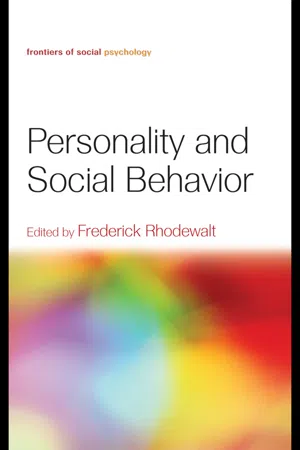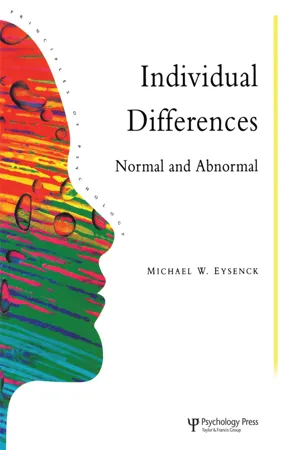Dispositional Factors Social Influence
Dispositional factors refer to individual traits, such as personality, attitudes, and beliefs, that influence behavior. Social influence encompasses the impact of others on an individual's thoughts, feelings, and actions. When considering dispositional factors in social influence, psychologists examine how an individual's inherent characteristics interact with external social pressures to shape behavior and decision-making.
5 Key excerpts on "Dispositional Factors Social Influence"
- eBook - ePub
- Frederick Rhodewalt, Frederick Rhodewalt(Authors)
- 2012(Publication Date)
- Psychology Press(Publisher)
...Interactional and situational perspectives on personality allow the social context a greater role in human behavior, but from a social identity perspective they nevertheless talk about dispositions being contextually-elicited or people being disposed to “choose” certain situations. This still underplays the notion of a multifaceted self and the role played by group membership and collective self-conception in behavior. Overall, contemporary social identity research tends to view personality less as a cause of behavior than as a social construct in which people make inferences about stable underlying dispositions or human essences (e.g., Haslam, Rothschild, & Ernst, 1998), for example, in the construction of a charismatic personality for a group’s leader or stereotype-consistent racial essences. In a similar vein individual differences are not so much viewed as idiosyncratic attributes that are brought to the group as socially constructed positions within the group based on perceived group prototypicality, positions that nevertheless have far reaching consequences for the group and the individual in terms of relative impact on group life and on how one is treated by the group (the psychology of social influence, persuasion, leadership, deviance, and marginalization). One feature of individuality that remains relatively unexplored by social identity researchers is how close interpersonal relationships articulate with group life and social identity processes...
- eBook - ePub
- Donald Pennington(Author)
- 2018(Publication Date)
- Routledge(Publisher)
...In some ways this is part of the problem of which five traits should be in the big five. Different psychologists may come up with different names for the big five depending on how they see the cluster of traits produced by factor analysis. Finally, the dispositional approach is characterised as one producing numerous questionnaires to assess or measure personality. The question arises as to whether such questionnaires actually measure the dispositions they claim to measure, or whether the scores reflect how people respond to personality questionnaires. Because most use one or another type of self-rating scale, the psychologist has to assume that the person is answering honestly and openly. But this may not necessarily be the case and the responses people give could reflect a range of underlying motives. One of the most commonly recognised is that of social desirability – the wish to present yourself in a more socially desirable light than is actually the case. Some questionnaires, as we have seen with Eysenck’s, build in questions to check if a person is answering in such a way. If they are then the validity of all their responses comes into question. On a more positive note, the dispositional approach has been highly influential, especially in developing personality tests. Such tests, of which there are very many, have enjoyed widespread application in clinical areas and organisational psychology especially. 6.7 SUMMARY • Dispositions or traits are internal dispositions that are relatively stable over time and across situations. Dispositions are regarded as predictive of behaviour. Dispositions have most commonly been conceptualised as bipolar adjectives such as introversion–extroversion. Interest in describing behaviour using dispositions dates back to Ancient Greek times and Galen’s theory of the four humours...
- eBook - ePub
- Thomas Blass, Thomas Blass(Authors)
- 2015(Publication Date)
- Psychology Press(Publisher)
...551]." Yet, over the years there have been researchers both within the field, as well as in the neighboring disciplines of personality, motivation, and clinical psychology who have been developing personality constructs to provide systematic accounts of behavioral variation among individuals. A primary purpose of this book is to provide concrete evidence for the usefulness of taking individual differences into account in making more precise predictions about social behavior, by presenting in the subsequent chapters several of these important personality variables which have relevance for social behavior. No attempt to account for the relative neglect of personality variables by social psychologists would be complete without mentioning the impact of criticisms which have been leveled periodically at the concept of transsituational personality dispositions or traits (e.g., Bern, 1972; Guthrie, 1944; Mischel, 1968, 1969; Wallace, 1966). Guthrie (1944), for example, stated: "The search for universal traits, or traits that attach to all of an individual's behavior, is mistaken in its conception and bound to fail [p. 63]." My intent in this introductory chapter is to provide a context for the chapters that follow by presenting salient issues that enter into a consideration of the relative roles of personality and situational factors in accounting for social behavior. While I will take up some of the issues involved in the "trait versus situation" controversy and hopefully provide some new perspectives on it, is not my primary purpose to wade deeply into the fray. Articulate presentations of predispositional viewpoints of personality have been given by a number of writers (e.g., Alker, 1972; Allport, 1937, 1961, 1966; Averill, 1973; MacKinnon, 1944 2 ; Wachtel, 1973)...
- eBook - ePub
Individual Differences
Normal And Abnormal
- Michael W. Eysenck, University of London College(Authors)
- 2014(Publication Date)
- Psychology Press(Publisher)
...The other person, in similar fashion, will be aware of the impression he or she makes and will form an impression of you. The personality you display in a given situation is determined at least in part by all of these factors, and not simply by your inherited personality. Of particular importance, the way in which you behave in an interpersonal situation is determined to a large extent by the behaviour and attitudes towards you displayed by the other person or people. Evidence of the impact that someone else’s behaviour can have was obtained in a study using an interview situation, in which participants were asked questions designed to produce either extraverted or introverted behaviour. A sample extraverted question is “What would you do if you wanted to liven things up at a party?”, and a sample introverted question is “What things do you dislike about loud parties?”. As predicted, participants who had behaved in an extraverted fashion in the interview rated themselves afterwards as more extraverted than those who had behaved in an introverted fashion. Raters agreed with the participants’ assessment of their own personalities. Even more striking evidence of how our behaviour and personality are influenced by other people was obtained in another study. Subjects were led to believe that another person either liked or disliked them. Those subjects who thought the other person liked them behaved in a much friendlier way than those subjects who believed themselves disliked: they revealed more about themselves, used a more positive tone of voice, had a more positive general attitude, disagreed less, and expressed dissimilarity less. Thus, it seems that our behaviour and personality are moulded to some extent by the views that we believe others hold about us. Summary: Personality—factor theories • Personality is generally regarded as referring to stable internal factors which underlie consistent individual differences in behaviour...
- eBook - ePub
Personal Relationships
Their Structures and Processes
- Harold H. Kelley(Author)
- 2013(Publication Date)
- Psychology Press(Publisher)
...The Attribution and Manifestation of Interpersonal Dispositions 4 The theme of this chapter can best be expressed by quoting from Fritz Heider’s seminal work, The Psychology of Interpersonal Relations (1958): It is an important principle of common-sense psychology, as it is of scientific theory in general, that man grasps reality, and can predict and control it, by referring transient and variable behavior and events to relatively unchanging underlying conditions, the so-called dispositional properties of his world [p. 79]. For a concrete illustration, let us assume that a person, p, is confronted with an agreeable, happy experience, x. This is the raw material at a level close to the peripheral stimulus. The next step of interpretation may be: What is the immediate source of x? Is it chance? Am I the cause of it? Or is another person, o, the cause? If o is accepted as cause, the question of motive or intention may well arise. Did he do it in order to please me, or was the event only an accidental by-product of a different goal? Perhaps he was ordered to help me, perhaps he did it to put me under an obligation to him, or to relieve his conscience, or to please someone else. But if p perceives o as really wanting to please him, there are still deeper layers of interpretation possible. The need “o wants to please p” may be caused by temporary goodwill in o ; it may be “displaced love”; or it may come from a more permanent sentiment that o feels toward p. Finally, the underlying attitude itself may be traced to further sources. For example, p may feel that o ’s attitude toward him is a function of o ’s personality, that o is a kind person. Or, p, may feel that the sentiment stems from the compatibility in their natures, etc. Underscoring the main points of this illustration, we note first, that man is usually not content simply to register the observables that surround him; he needs to refer them as far as possible to the invariances of his environment...




